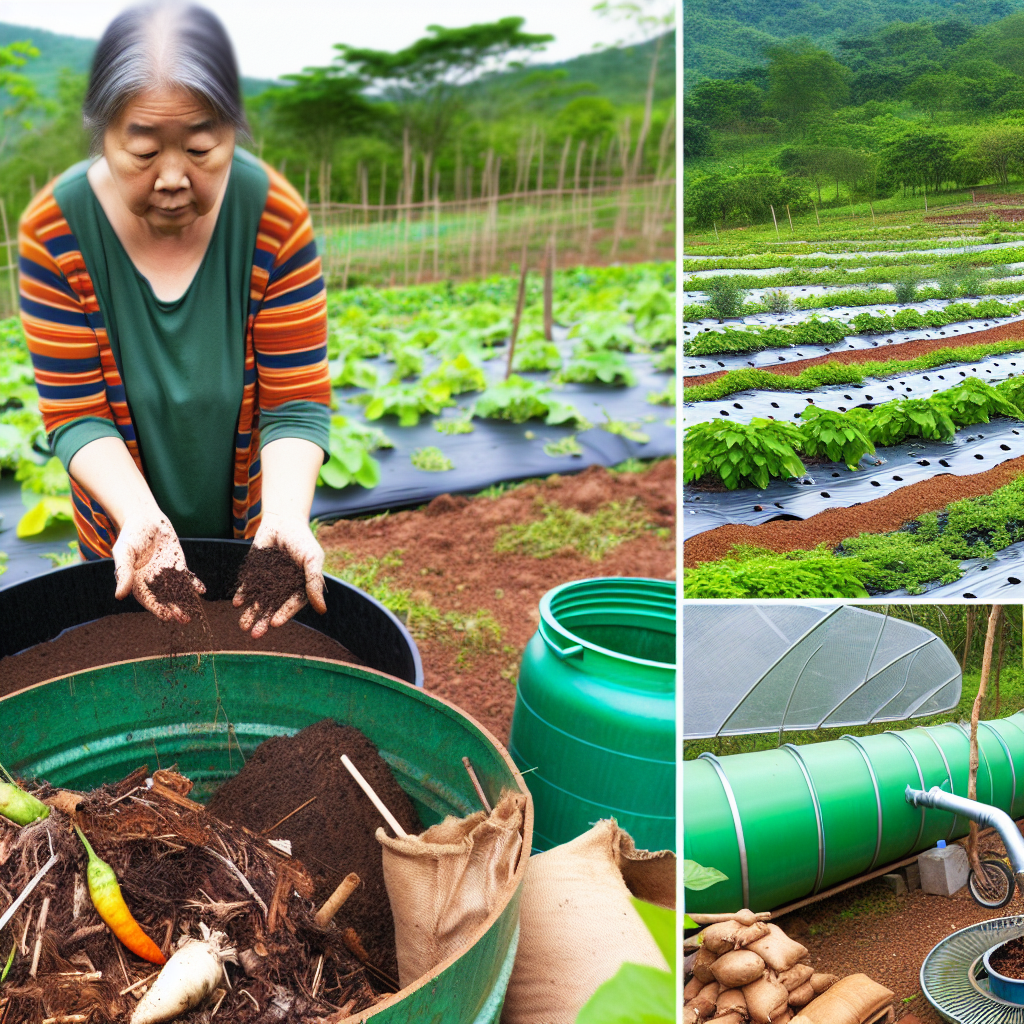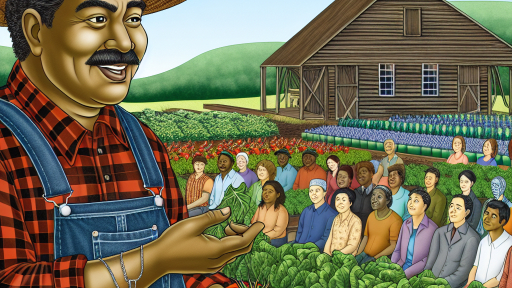Introduction to Permaculture: Principles and Ethics
Understanding Permaculture
Permaculture combines ecological principles with agricultural practices.
It promotes sustainable farming and land use.
This method focuses on creating beneficial relationships within ecosystems.
Core Principles of Permaculture
Permaculture operates on several key principles.
- Observe and interact with nature.
- Catch and store energy efficiently.
- Use renewable resources thoughtfully.
- Design from patterns to details.
- Integrate rather than segregate elements.
These principles guide practitioners in crafting sustainable systems.
The Ethics of Permaculture
Permaculture is rooted in three core ethics.
- Care for the earth ensures ecological health.
- Care for people promotes community well-being.
- Fair share advocates for equitable resource distribution.
Following these ethics fosters a responsible approach to farming.
The Role of Community in Permaculture
Community involvement enhances permaculture practices.
People working together can create more resilient systems.
Additionally, sharing knowledge is essential for success.
Community gardens often exemplify collaborative permaculture efforts.
Designing Permaculture Layouts: Zones and Sectors
Understanding Zones in Permaculture
Zones are essential in permaculture design.
They help in organizing the space around your farm.
Typically, zones range from one to five.
Zone one is closest to the home.
Transform Your Agribusiness
Unlock your farm's potential with expert advice tailored to your needs. Get actionable steps that drive real results.
Get StartedIt includes plants and resources needing frequent access.
Zone two may contain your vegetable garden.
Here, you can manage crops with moderate attention.
Zone three often features larger crops like grains.
Only visit this area periodically for maintenance.
Zones four and five are less intensive.
These areas can support natural ecosystems.
Wildlife habitats and untouched nature flourish here.
Identifying Sectors in Permaculture
Sectors analyze external influences affecting your farm.
These can include wind, sunlight, and wildlife activity.
Understanding your property’s sectors aids in effective planning.
Start by observing the sun’s path throughout the day.
Also note wind patterns during different seasons.
Use this information to place elements wisely.
For example, a windbreak can protect crops.
Additionally, consider how wildlife interacts with your plants.
Integrating Zones and Sectors
Integrating zones and sectors creates an efficient design.
Begin by sketching the layout of your property.
Next, mark your zones based on accessibility needs.
Then, overlay sectors to highlight environmental factors.
This approach allows for a harmonious relationship between elements.
For instance, position a chicken coop near zone one.
It will provide eggs and pest control to your garden.
Ultimately, effective integration enhances productivity.
Showcase Your Farming Business
Publish your professional farming services profile on our blog for a one-time fee of $200 and reach a dedicated audience of farmers and agribusiness owners.
Publish Your ProfileUtilizing Guilds to Enhance Design
Guilds are a crucial aspect of permaculture design.
A guild is a grouping of plants supporting each other.
For instance, the “Three Sisters” is a famous guild.
This includes corn, beans, and squash.
They work together to maximize space and yield.
When designing, consider creating multiple guilds in zones.
Each guild can adapt to specific sector influences.
As a result, you promote biodiversity within your farm.
Soil Health and Fertility
Importance of Soil in Sustainable Farming
Soil health is crucial for sustainable farming practices.
It directly affects plant growth and crop yield.
Healthy soil retains moisture and nutrients efficiently.
Moreover, it supports beneficial microorganisms and organisms.
Techniques to Enhance Soil Health
Implement crop rotation to prevent nutrient depletion.
This practice fosters diversity and improves soil structure.
Additionally, cover crops help shield soil from erosion.
They also add organic matter back into the soil.
Utilizing Compost
Composting enriches the soil with nutrients.
It improves soil texture and water retention capabilities.
Furthermore, composting reduces the need for chemical fertilizers.
Applying Mulch
Mulching conserves soil moisture and suppresses weeds.
This practice maintains a stable soil temperature.
Organic mulches also decompose, enhancing soil fertility.
Integrating Organic Matter
Incorporating organic matter enhances nutrient availability.
It also improves soil structure and aeration.
The addition of organic materials supports biodiversity in soil life.
Utilizing Green Manure
Green manure refers to crops grown specifically to enhance soil health.
These crops are tilled back into the soil before flowering.
This method enriches the soil with nitrogen and other nutrients.
Implementing No-Till Farming
No-till farming preserves soil structure and biology.
This technique reduces soil erosion significantly.
Additionally, it improves water infiltration and retention.
Monitoring Soil Health
Regularly testing soil is essential for monitoring health.
Soil tests reveal nutrient levels and pH balance.
This information aids in making informed amendments.
Utilizing Soil Amendments
Soil amendments improve soil qualities that support plant growth.
Common amendments include lime, sulfur, and gypsum.
These amendments address specific nutrient deficiencies effectively.
See Related Content: Supporting Youth Agriculture Through School Programs
Water Management in Permaculture: Techniques for Conservation
Understanding Water’s Role in Permaculture
Water is vital for all living organisms.
In permaculture, effective water management enhances productivity.
Showcase Your Farming Business
Publish your professional farming services profile on our blog for a one-time fee of $200 and reach a dedicated audience of farmers and agribusiness owners.
Publish Your ProfileAdditionally, it promotes ecological balance in farming systems.
Techniques for Water Conservation
Various techniques exist to conserve water in permaculture systems.
These can significantly reduce water waste and promote sustainability.
Creating Swales
Swales are shallow trenches designed to capture runoff.
They direct water to plants, enhancing soil moisture.
Furthermore, swales prevent soil erosion by slowing water flow.
Implementing Rainwater Harvesting
Rainwater harvesting collects rain for future use.
Install tanks or cisterns to store excess rainwater.
This technique reduces dependence on other water sources.
Utilizing Permeable Surfaces
Permeable surfaces allow water infiltration into the ground.
Use gravel, bricks, or porous asphalt for pathways.
This method helps recharge groundwater supplies effectively.
Designing Landscapes for Water Efficiency
A well-designed landscape captures and utilizes water effectively.
Choose plants native to the region for improved water efficiency.
These plants typically require less irrigation.
Implementing Keyline Design
Keyline design optimizes the land’s natural contours.
This technique enhances water distribution across the landscape.
As a result, it maximizes water retention in the soil.
Using Mulching for Soil Moisture
Mulching helps retain moisture in the soil.
Apply organic materials like wood chips or straw.
This practice also suppresses weed growth effectively.
Monitoring and Adjusting Practices
Regular assessment of water use enhances efficiency.
Monitor soil moisture levels to adjust watering practices accordingly.
This approach ensures the sustainability of water resources.
Explore Further: Farm-To-Table Ethical Supply Chain
Diverse Plant Selection: Companion Planting and Polyculture
Introduction to Diverse Plant Selection
Diverse plant selection is vital for sustainable farming.
This practice enhances ecosystem resilience.
Moreover, it promotes healthier soil and plants.
Benefits of Companion Planting
Companion planting involves growing different crops together.
This strategy maximizes space and yields.
Certain plant combinations repel pests effectively.
For example, marigolds can deter nematodes around tomatoes.
Additionally, beans fix nitrogen, benefiting nearby crops.
- Enhances biodiversity
- Improves soil health
- Reduces pest infestations
Understanding Polyculture
Polyculture involves cultivating multiple crops in the same area.
This method mimics natural ecosystems.
Each plant contributes uniquely to the landscape.
For instance, deep-rooted plants access different nutrients.
Consequently, polyculture boosts overall productivity.
Building a Polyculture System
Start by selecting compatible plants.
Consider crop height, nutrient needs, and pest resistance.
Showcase Your Farming Business
Publish your professional farming services profile on our blog for a one-time fee of $200 and reach a dedicated audience of farmers and agribusiness owners.
Publish Your ProfileSecondly, plan your layout strategically.
Group plants that benefit from each other.
- Group tall crops with shade-tolerant ones
- Mix dynamic accumulators with other species
- Incorporate flowers to attract pollinators
Challenges and Considerations
While effective, diverse plant selection requires careful planning.
Farmers must monitor growth and interactions between plants.
Furthermore, local climate and soil conditions play significant roles.
Strategies to Overcome Challenges
Start small with a few plant combinations.
This approach allows for testing and adjustments.
Additionally, engaging with local agricultural communities can provide insights.
Sharing experiences often leads to innovative solutions.
You Might Also Like: CSA Membership Essentials for Farmers

Integrating Animals
Benefits of Animal Husbandry in Permaculture
Animal husbandry plays a vital role in permaculture systems.
It enhances biodiversity while maintaining ecological balance.
By incorporating livestock, farmers can utilize natural processes effectively.
For instance, animals help in pest control and nutrient cycling.
Enhancing Soil Fertility
Animals contribute significantly to soil health and fertility.
Animal manure serves as an excellent organic fertilizer.
This enriches the soil with essential nutrients and microorganisms.
Moreover, it improves soil structure and moisture retention.
Natural Pest Management
Integrating animals aids in managing pests naturally.
Chickens consume insects and weeds, reducing the need for chemicals.
Furthermore, livestock trample down overgrown plants, promoting a balance.
This approach minimizes pest outbreaks and supports ecosystem health.
Support for Crop Production
Animals can significantly support crop production in permaculture.
For example, rotational grazing improves pasture quality.
It prevents overgrazing and ensures vibrant crop growth.
Additionally, animals can help in tilling the soil naturally.
Economic Benefits
Animal husbandry in permaculture offers economic advantages.
Farmers can diversify their income through livestock sales.
Egg, milk, and wool production provide additional revenue streams.
Moreover, integrating animals reduces reliance on purchased fertilizers.
Explore Further: Community Supported Agriculture Benefits For Farmers
Implementing Permaculture: Case Studies and Success Stories
Overview of Successful Permaculture Implementations
Globally, permaculture practices have transformed agricultural landscapes.
Many farmers embraced these techniques to enhance sustainability.
In various regions, unique case studies illustrate its success.
Case Study: Green Haven Farm
Green Haven Farm operates in Oregon, focusing on biodiversity.
The owners, Elena and Marco, employ multiple cropping systems.
This strategy promotes soil health and reduces pests.
Moreover, they utilize natural water management techniques.
As a result, their yields increased significantly over five years.
Case Study: EcoVillage in Ithaca
The EcoVillage project in Ithaca, New York, exemplifies community effort.
Showcase Your Farming Business
Publish your professional farming services profile on our blog for a one-time fee of $200 and reach a dedicated audience of farmers and agribusiness owners.
Publish Your ProfileThis initiative integrates permaculture design into urban spaces.
Residents grow food cooperatively, enhancing food security.
Furthermore, they emphasize waste reduction through composting.
The community maintains educational programs on sustainable practices.
Case Study: Permaculture Research Institute
This institute in Australia focuses on permaculture education.
They offer workshops that teach sustainable farming techniques.
Participants learn about soil regeneration and water conservation.
Additionally, they promote native plant cultivation for biodiversity.
Their alumni often start successful permaculture projects globally.
Challenges and Resilience
Implementing permaculture is not without challenges.
Farmers face initial costs for transitioning their land.
They also contend with a lack of immediate results.
Nevertheless, successful stories highlight resilience over time.
Key Takeaways
- Permaculture enhances biodiversity and soil health.
- Community involvement boosts sustainability efforts.
- Education plays a crucial role in spreading awareness.
- Long-term benefits often outweigh short-term challenges.
Challenges and Solutions: Overcoming Barriers to Permaculture Adoption
Understanding Common Barriers
Permaculture adoption faces several common barriers.
Firstly, lack of awareness hampers interest in sustainable practices.
Many farmers do not fully understand permaculture principles.
This knowledge gap leads to resistance against change.
Additionally, financial constraints deter potential implementers.
Setting up a permaculture system requires investment.
Many farmers struggle to make this initial financial commitment.
Furthermore, traditional agriculture education often overlooks permaculture.
Thus, many agricultural programs do not provide adequate training.
Innovative Solutions for Awareness
Education plays a crucial role in overcoming awareness barriers.
Workshops can highlight the benefits of permaculture.
Community programs can connect local farmers with experts.
Additionally, farmers can share their success stories.
This sharing builds a sense of community and motivation.
Addressing Financial Constraints
Financial challenges demand creative solutions.
Farmers can access grants that support sustainable farming projects.
Local governments may also offer low-interest loans for transitioning.
Collaborative community ventures can reduce individual financial burdens.
Moreover, establishing cooperative networks can spread costs.
Enhancing Agricultural Education
Integrating permaculture into agricultural curriculums is essential.
Schools and universities can develop specialized courses.
This approach ensures future farmers understand sustainable practices.
Furthermore, online courses and resources can widen accessibility.
Educational outreach should target diverse farming communities.
Building a Supportive Community
A strong support network promotes permaculture adoption.
Local groups can encourage collaboration among farmers.
These groups may host events and activities showcasing permaculture.
Showcase Your Farming Business
Publish your professional farming services profile on our blog for a one-time fee of $200 and reach a dedicated audience of farmers and agribusiness owners.
Publish Your ProfileCreating a mentorship program connects experienced farmers with novices.
This support fosters confidence in implementing new practices.




